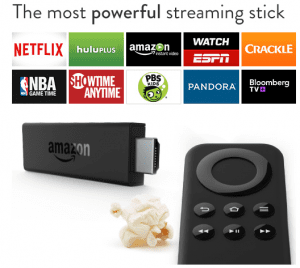
Yesterday, I shared that Amazon has announced the upcoming release of their Amazon Fire TV Stick – a tiny little device that will allow you to stream Internet programming directly to your TV.
For the next 36 hours, you can pre-order the Stick for just $19 — $20 less than it’s regular $39 price-tag. The device will ship to you on November 19th, as soon as it’s released. (I just noticed that Amazon update the verbiage and said “Due to Demand”… orders placed may not arrive until January 1. If you ordered yesterday, you are still guaranteed to get yours on November 19th. My best guess is that this “warning” is hype and you’ll still get your stick on November 19th, but I did want you to have fair notice that this may not ship next month after all.)
So, a number of you had questions about what the Stick is, how it works and what it will replace, particularly in terms of your current cable package.
Like the Roku, Apple TV and Chromecast before it, the Amazon Fire TV (currently $99, though it’s been less over the last couple of months) and the Amazon Fire TV Stick (currently $19, regularly $39) are devices that deliver Internet-available programming to your television.
If you bought a Smart TV in the last two years, you probably already have all or most of this content on your television. If you own an enabled Blu-Ray/DVD or game system (XBox or Play Station), you may also already have access to this programming. Likewise if you already have a Roku or Apple TV (or the Chromecast, which came out last year at this time), then you, too, already have access to much of this content as well.
Okay, so now that we know who doesn’t need the stick, who does need it?
Anyone who wants to stream mainstream movies, TV shows and even music thru services (some paid, some free) like Amazon Instant Video, Apple’s iTunes Store, Google Play, Netflix, Hulu Plus, PBS Kids, Watch ESPN, Pandora, iHeartRadio, and Spotify.
For your Amazon Stick (or any other streaming device, for that matter) to work, you need to connect it to your home’s WiFi network. Note that you need to have an Internet connection of at least 1.5 megabits per second — and faster if you will be watching HD programming (probably closer to 8 Mbps).
The Stick plugs directly into the HDMI port on your television — so if your TV is not a flat screen, and/or if it’s 10+ years old, you need to make sure you have a this port before buying this devise.
Once your Stick is plugged in and hooked up to the Internet, you can pick which services and channels you want access to. To set this up, you will use your remote that comes with your Stick to navigate the displayed screen on your television, or — if you buy the Amazon Fire TV box (rather than the stick), it’s actually voice-activated, so you can just talk to it!
If you have a subscription to Netflix or Hulu Plus, for example, you will connect your subscription to the device, so you can stream movies directly to your TV (via the Stick). If you are a member of Amazon Prime, you instantly have access to the massive Amazon Instant Video library.
The Amazon Fire TV Stick comes with a free one-month trial of Netflix, if you’re not currently a subscriber. (For what it’s worth, we never found that we needed Netflix. Between all the content with Amazon Prime, plus the stuff we check out from the library, we’re not hurting from programs to watch.)
The Stick also has a number of built-in applications for children, such as PBS Kids, which will provide even more free content.
Now, if you are a sports addict like some of my family members, the Amazon Fire TV & Amazon Fire TV Stick also come with Watch ESPN, NBA Game Time and NFL Now. Unfortunately, I think all of these require a user name and password from a cable account (if you don’t have cable, but your family member does – you might want to ask to borrow their login information!)
Can the Amazon Stick (or Roku, or Apple TV, or Chromecast) really make it possible for you to cut the cord? Honestly, it depends on your watching habits. You will still probably want a high power antenna (stay tuned next month for my review of the Mohu – the world’s thinnest, most powerful antenna), and you may have to deal without all the live sports in your living room (it’s hard, I know!). The trade-off is definitely worth considering, though, since you will save hundreds, if not thousands, of dollars every year. And after being cable-free for seven years, I can honestly say, there’s not much we miss!















Connects via HDMI port to TV. USB is used for power…. can be plugged into wall outlet
Thanks!
Can this work worldwide like in the Caribbean
I’m not sure, Kerry – I’d suggest contacting Amazon’s customer service. I bet they can help you.